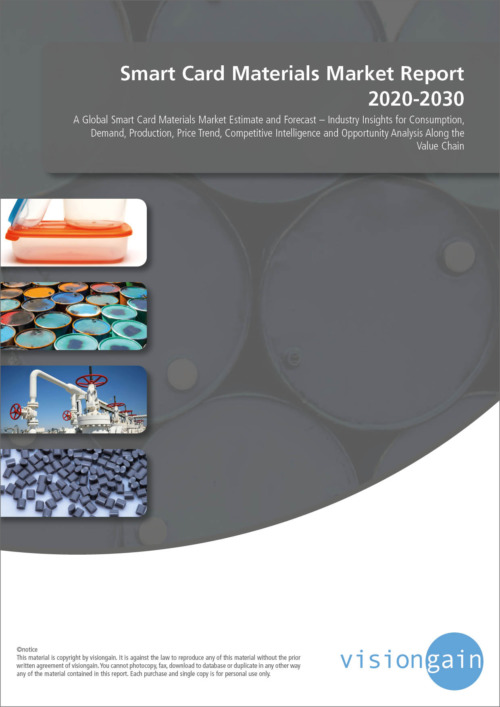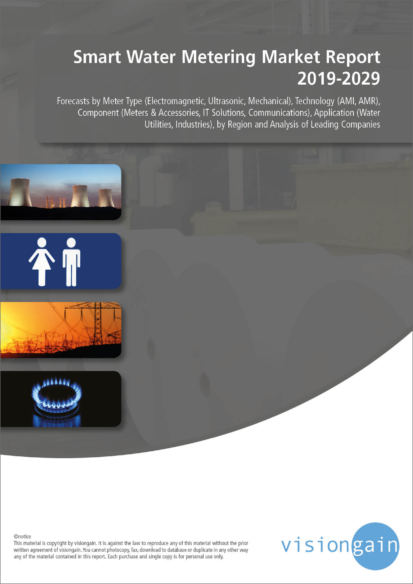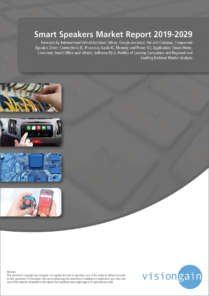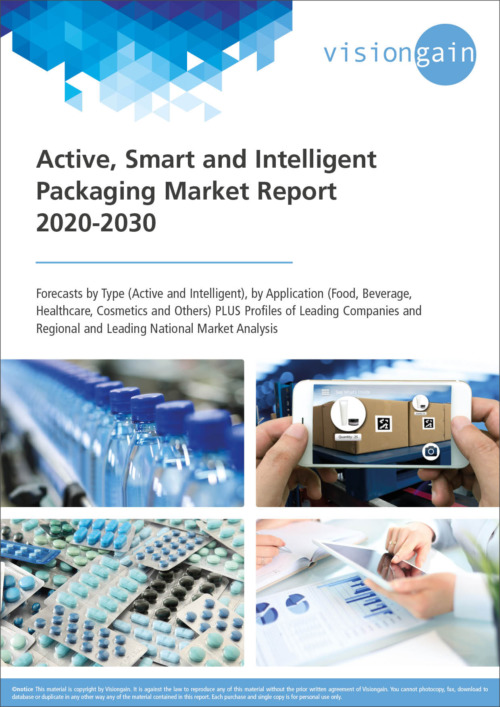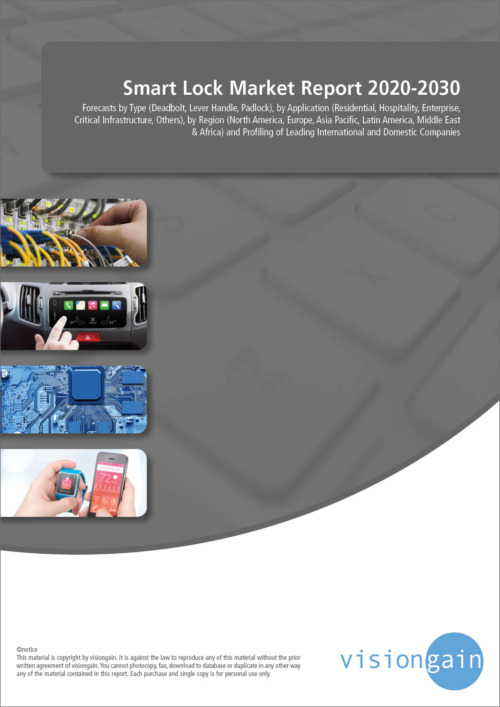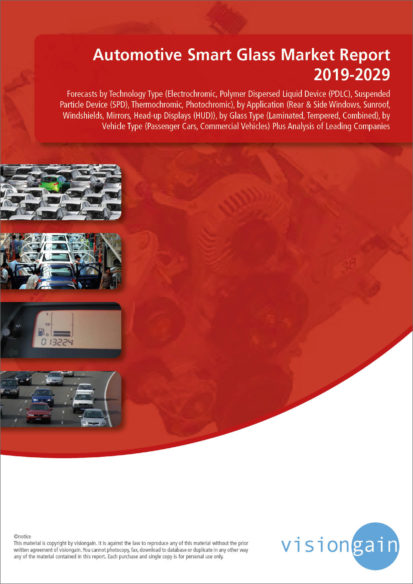The global smart card materials market was valued at $995.7 million in 2018. The growth of the market is attributed to the increasing adoption of smart cards by millions of users globally. Smart cards enable secure payment facilities, point of sale transactions and helps in protecting computers. Increasing cases of cybercrime and beach of data is enhancing the need for adopting smart card technology that also helps in enhancing the security of internet of things (IoT).
Smart card is a card that is used, which has the capacity of connecting information to a specific application such as optical cards, microprocessor cards, magnetic stripe cards and memory cards. The ability to modify and record information in its own physically protected and non-volatile memory thus makes the smart card a practical and authoritative tool. Moreover, these cards have the capacity to engage with computer systems and enable the users to update information promptly thus bolstering the growth of global smart card materials market at significant rate.
Increasing emphasis of economies towards cashless transactions is the key factor driving the growth of the global smart card materials market. The cashless payment options is becoming popular and the most preferred option as it uses net banking, credit and debit cards for making digital purchase transactions. It further enables users to pay their online bills and manage finances with the help of smartphones and laptops. Cashless payments makes life easy, flexible and also helps the consumers to formalize and authenticate their transactions that enables government to monitor flow of black money that further elaborates economic growth of the nation.
Furthermore, the expenditure incurred due to printing and further transportation of currency notes is thus reduced at a certain extent. The countries such as India are trying to make technological advancements in order to make their economy cashless and create a strong cashless economy. Moreover, extensive demand for secure and reliable payment transactions is other factor pertaining towards the growth of global smart card materials market. However, increasing number of cases of cybercrimes and data breach is the key factor that is anticipated to hinder the growth of global smart card materials market.
Smart card materials market forecast 2020 – 2030 estimates the historical market size in terms of revenue generated by the industry players across the globe. It offers the opportunity analysis along the value chain for the smart card materials manufacturers. Also, the report offers the vendor analysis along with price trend which provides an edge to the stakeholders especially manufacturers to create a better understanding of the market. Government, retail, healthcare, BFSI, hospitality, telecommunication, and other industry players benefit from the product benchmarking and matrix helping them to take right decision in choosing the right product with optimum prices suited for their end use applications.
The reports provide the analysis based on materials, types, and application segment. On the basis of materials, the global smart card materials market is classified into polycarbonate, polyethylene terephthalate-glycol, polyvinyl chloride, acrylonitrile butadiene styrene, and others. Among all these segments, polyvinyl chloride is anticipated to witness highest CAGR during the forecast period owing to increasing polyvinyl chloride for manufacturing of smart cards. Polyvinyl Chloride comprises of effective mechanical, chemical and thermal property and is used in the form of films for development of various types of smart cards.
Based on types, the global smart card materials market is categorised into contactless cards, contact cards, and multi-component cards. Among these segments, multi-component cards are expected to witness highest CAGR during the forecast period as these cards store customers information that can be used by both contactless and contact cards. These cards are considered to provide secure payment transactions due to its encrypted feature such as fingerprint sensor is inscribed on the card that makes it an attractive and safer payment option.
On the basis of application, the global smart card materials market is segmented into government, retail, healthcare, BFSI, hospitality, telecommunication, and others. Among all these segments, BFSI sector is expected to witness CAGR of xx% during the forecast period owing to increasing emphasis of government on various economies to go cashless that is thus accelerating the requirement for banks to become technologically upgraded in order to regulate efficient online payment transactions.
Smart card materials market in Asia-Pacific is predicted to grow at the fastest rate during the forecast period owing to increasing population, increasing adoption of smart devices and propelling digital services in countries such as India and China. Moreover, the region is observing rampant demand for debit cards, credit cards, ID recognition cards and gift cards from various customers. Additionally, introduction of several saving systems for dealers of payment brands is further boosting the growth of smart card materials market in this region.
The report also offers the insights for the North American, European, Latin American, and Middle East and African Market. A detail analysis of historic and forecast consumption data, revenue in the market and competitive analysis for major competitors in each region is also provided.
The eminent key players in the global smart card materials market are entering into partnership agreements and performing mergers & acquisitions that are considered to be the key development strategies being implemented by the crucial players in global smart card materials market.
Some of the players having prominent presence in the global smart card materials market include Formosa Plastics Group, Solvay SA, Kem One SAS, Eastman Chemical Company, PetroChina Company Limited, 3A Composites GmbH, SK Chemicals, Teijin Ltd., SABIC Innovative Plastics, Axiall Corporation, BASF SE, and LG Chemicals.
Visiongain is a trading partner with the US Federal Government
CCR Ref number: KD4R6
Do you have any custom requirements we can help you with? Any need for specific country, geo region, market segment or specific company information? Contact us today, we can discuss your needs and see how we can help: sara.peerun@visiongain.com
1. Research Overview
1.1. Objective
1.2. Global Smart Card Materials Market Overview
1.3. Market Segmentation
1.3.1. By Materials
1.3.2. By Types
1.3.3. By Application
1.4. Benefits to Stakeholders
1.5. Key Questions Answered by the Report
1.6. Frequently Asked Questions
2. Research Methodology
2.1.1. Secondary Research
2.1.1.1. Key secondary research sources
2.1.2. Primary Research
2.1.2.1. Split of primary research respondents
2.1.2.1.1. By industry participant
2.1.2.1.2. By region
2.1.2.1.3. By company type
2.1.3. Market Estimation and Forecast Methodology
2.1.4. Data Exploration and Validation
2.1.5. Limitations and Assumptions for the Study
3. Introduction to the Smart Card Materials Market
3.1. Market Definition
3.2. By Materials
3.2.1. Polyvinyl Chloride (PVC)
3.2.2. Polycarbonate (PC)
3.2.3. Acrylonitrile Butadiene Styrene (ABS)
3.2.4. Polyethylene Terephthalate-Glycol (PETG)
3.2.5. Others
3.3. By Types
3.3.1. Small & Extra Small (S & XS)
3.3.2. Contactless Cards
3.3.3. Contact Cards
3.3.4. Multi-Component Cards
3.4. By Application
3.4.1. Government
3.4.2. Retail
3.4.3. Healthcare
3.4.4. BFSI
3.4.5. Telecommunication
3.4.6. Others
4. Raw Material Price Analysis
4.1. Polycarbonate (PC)
4.2. Polyvinyl Chloride (PVC)
4.3. Acrylonitrile Butadiene Styrene (ABS)
4.4. Polyethylene Terephthalate Glycol (PETG)
5. Smart Card Materials Market Analysis
5.1. Industry Outlook
5.2. Demand Side Trends
5.3. Supply Side Trends
5.4. Value Chain Analysis
5.5. Technology Overview
5.6. Regulatory Framework
5.7. Distribution Channel Analysis
5.8. PESTEL Analysis
5.9. Opportunity Analysis
5.10. Supply Chain Analysis
5.11. Porter’s Five Forces Analysis
5.11.1. Bargaining Power of Buyers
5.11.2. Bargaining Power of Suppliers
5.11.3. Threat of New Entrants
5.11.4. Rivalry Among Existing Competitors
5.11.5. Threat of Substitutes
5.12. Market Dynamics
5.12.1. Drivers
5.12.1.1. Increasing inclination toward cashless payments
5.12.1.2. Cost saving schemes for merchants of payment brands
5.12.1.3. Growing demand for reliable and secure payment transactions
5.12.2. Restraints
5.12.2.1. Fluctuating materials prices
5.12.3. Trends
5.12.3.1. Shifting towards digitization
5.12.4. Opportunities
5.12.4.1. Emerging nations offers huge opportunity
5.13. SWOT Analysis of the Smart Card Materials Market
5.13.1. Strength
5.13.2. Weakness
5.13.3. Opportunity
5.13.4. Threat
6. Smart Card Materials: Global Market
6.1. Global Smart Card Materials Market Forecast 2020 – 2030
6.2. Global Smart Card Materials Market Forecast, by Materials, 2020 – 2030
6.3. Global Smart Card Materials Market Forecast, by Types, 2020 – 2030
6.4. Global Smart Card Materials Market Forecast, by Application, 2020 – 2030
6.5. Global Smart Card Materials Market Forecast, by Region, 2020 – 2030
6.5.1. Asia-Pacific
6.5.2. Europe
6.5.3. North America
6.5.4. Latin America
6.5.5. Middle East & Africa
7. Smart Card Materials: Asia-Pacific Market
7.1. China Smart Card Materials Market
7.1.1. China Smart Card Materials Market, by Materials Forecast, 2020 – 2030
7.1.2. China Smart Card Materials Market, by Types Forecast, 2020 – 2030
7.1.3. China Smart Card Materials Market, by Application Forecast, 2020 – 2030
7.2. Japan Smart Card Materials Market
7.2.1. Japan Smart Card Materials Market, by Materials Forecast, 2020 – 2030
7.2.2. Japan Smart Card Materials Market, by Types Forecast, 2020 – 2030
7.2.3. Japan Smart Card Materials Market, by Application Forecast, 2020 – 2030
7.3. India Smart Card Materials Market
7.3.1. India Smart Card Materials Market, by Materials Forecast, 2020 – 2030
7.3.2. India Smart Card Materials Market, by Types Forecast, 2020 – 2030
7.3.3. India Smart Card Materials Market, by Application Forecast, 2020 – 2030
7.4. Australia Smart Card Materials Market
7.4.1. Australia Smart Card Materials Market, by Materials Forecast, 2020 – 2030
7.4.2. Australia Smart Card Materials Market, by Types Forecast, 2020 – 2030
7.4.3. Australia Smart Card Materials Market, by Application Forecast, 2020 – 2030
7.5. South Korea Smart Card Materials Market
7.5.1. South Korea Smart Card Materials Market, by Materials Forecast, 2020 – 2030
7.5.2. South Korea Smart Card Materials Market, by Types Forecast, 2020 – 2030
7.5.3. South Korea Smart Card Materials Market, by Application Forecast, 2020 – 2030
7.6. Indonesia Smart Card Materials Market
7.6.1. Indonesia Smart Card Materials Market, by Materials Forecast, 2020 – 2030
7.6.2. Indonesia Smart Card Materials Market, by Types Forecast, 2020 – 2030
7.6.3. Indonesia Smart Card Materials Market, by Application Forecast, 2020 – 2030
7.7. Singapore Smart Card Materials Market
7.7.1. Singapore Smart Card Materials Market, by Materials Forecast, 2020 – 2030
7.7.2. Singapore Smart Card Materials Market, by Types Forecast, 2020 – 2030
7.7.3. Singapore Smart Card Materials Market, by Application Forecast, 2020 – 2030
7.8. Thailand Smart Card Materials Market
7.8.1. Thailand Smart Card Materials Market, by Materials Forecast, 2020 – 2030
7.8.2. Thailand Smart Card Materials Market, by Types Forecast, 2020 – 2030
7.8.3. Thailand Smart Card Materials Market, by Application Forecast, 2020 – 2030
7.9. Rest of Asia-Pacific Smart Card Materials Market
7.9.1. Rest of Asia-Pacific Smart Card Materials Market, by Materials Forecast, 2020 – 2030
7.9.2. Rest of Asia-Pacific Smart Card Materials Market, by Types Forecast, 2020 – 2030
7.9.3. Rest of Asia-Pacific Smart Card Materials Market, by Application Forecast, 2020 – 2030
8. Smart Card Materials: European Market
8.1. Germany Smart Card Materials Market
8.1.1. Germany Smart Card Materials Market, by Materials Forecast, 2020 – 2030
8.1.2. Germany Smart Card Materials Market, by Types Forecast, 2020 – 2030
8.1.3. Germany Smart Card Materials Market, by Application Forecast, 2020 – 2030
8.2. U.K. Smart Card Materials Market
8.2.1. U.K. Smart Card Materials Market, by Materials Forecast, 2020 – 2030
8.2.2. U.K. Smart Card Materials Market, by Types Forecast, 2020 – 2030
8.2.3. U.K. Smart Card Materials Market, by Application Forecast, 2020 – 2030
8.3. France Smart Card Materials Market
8.3.1. France Smart Card Materials Market, by Materials Forecast, 2020 – 2030
8.3.2. France Smart Card Materials Market, by Types Forecast, 2020 – 2030
8.3.3. France Smart Card Materials Market, by Application Forecast, 2020 – 2030
8.4. Spain Smart Card Materials Market
8.4.1. Spain Smart Card Materials Market, by Materials Forecast, 2020 – 2030
8.4.2. Spain Smart Card Materials Market, by Types Forecast, 2020 – 2030
8.4.3. Spain Smart Card Materials Market, by Application Forecast, 2020 – 2030
8.5. Italy Smart Card Materials Market
8.5.1. Italy Smart Card Materials Market, by Materials Forecast, 2020 – 2030
8.5.2. Italy Smart Card Materials Market, by Types Forecast, 2020 – 2030
8.5.3. Italy Smart Card Materials Market, by Application Forecast, 2020 – 2030
8.6. Russia Smart Card Materials Market
8.6.1. Russia Smart Card Materials Market, by Materials Forecast, 2020 – 2030
8.6.2. Russia Smart Card Materials Market, by Types Forecast, 2020 – 2030
8.6.3. Russia Smart Card Materials Market, by Application Forecast, 2020 – 2030
8.7. Rest of Europe Smart Card Materials Market
8.7.1. Rest of Europe Smart Card Materials Market, by Materials Forecast, 2020 – 2030
8.7.2. Rest of Europe Smart Card Materials Market, by Types Forecast, 2020 – 2030
8.7.3. Rest of Europe Smart Card Materials Market, by Application Forecast, 2020 – 2030
9. Smart Card Materials: North American Market
9.1. U.S. Smart Card Materials Market
9.1.1. U.S. Smart Card Materials Market, by Materials Forecast, 2020 – 2030
9.1.2. U.S. Smart Card Materials Market, by Types Forecast, 2020 – 2030
9.1.3. U.S. Smart Card Materials Market, by Application Forecast, 2020 – 2030
9.2. Canada Smart Card Materials Market
9.2.1. Canada Smart Card Materials Market, by Materials Forecast, 2020 – 2030
9.2.2. Canada Smart Card Materials Market, by Types Forecast, 2020 – 2030
9.2.3. Canada Smart Card Materials Market, by Application Forecast, 2020 – 2030
10. Smart Card Materials: Latin American Market
10.1. Brazil Smart Card Materials Market
10.1.1. Brazil Smart Card Materials Market, by Materials Forecast, 2020 – 2030
10.1.2. Brazil Smart Card Materials Market, by Types Forecast, 2020 – 2030
10.1.3. Brazil Smart Card Materials Market, by Application Forecast, 2020 – 2030
10.2. Mexico Smart Card Materials Market
10.2.1. Mexico Smart Card Materials Market, by Materials Forecast, 2020 – 2030
10.2.2. Mexico Smart Card Materials Market, by Types Forecast, 2020 – 2030
10.2.3. Mexico Smart Card Materials Market, by Application Forecast, 2020 – 2030
10.3. Argentina Smart Card Materials Market
10.3.1. Argentina Smart Card Materials Market, by Materials Forecast, 2020 – 2030
10.3.2. Argentina Smart Card Materials Market, by Types Forecast, 2020 – 2030
10.3.3. Argentina Smart Card Materials Market, by Application Forecast, 2020 – 2030
10.4. Chile Smart Card Materials Market
10.4.1. Chile Smart Card Materials Market, by Materials Forecast, 2020 – 2030
10.4.2. Chile Smart Card Materials Market, by Types Forecast, 2020 – 2030
10.4.3. Chile Smart Card Materials Market, by Application Forecast, 2020 – 2030
10.5. Colombia Smart Card Materials Market
10.5.1. Colombia Smart Card Materials Market, by Materials Forecast, 2020 – 2030
10.5.2. Colombia Smart Card Materials Market, by Types Forecast, 2020 – 2030
10.5.3. Colombia Smart Card Materials Market, by Application Forecast, 2020 – 2030
10.6. Rest of Latin American Smart Card Materials Market
10.6.1. Rest of Latin American Smart Card Materials Market, by Materials Forecast, 2020 – 2030
10.6.2. Rest of Latin American Smart Card Materials Market, by Types Forecast, 2020 – 2030
10.6.3. Rest of Latin American Smart Card Materials Market, by Application Forecast, 2020 – 2030
11. Smart Card Materials: MEA Market
11.1. Saudi Arabia Smart Card Materials Market
11.1.1. Saudi Arabia Smart Card Materials Market, by Materials Forecast, 2020 – 2030
11.1.2. Saudi Arabia Smart Card Materials Market, by Types Forecast, 2020 – 2030
11.1.3. Saudi Arabia Smart Card Materials Market, by Application Forecast, 2020 – 2030
11.2. South Africa Smart Card Materials Market
11.2.1. South Africa Smart Card Materials Market, by Materials Forecast, 2020 – 2030
11.2.2. South Africa Smart Card Materials Market, by Types Forecast, 2020 – 2030
11.2.3. South Africa Smart Card Materials Market, by Application Forecast, 2020 – 2030
11.3. U.A.E. Smart Card Materials Market
11.3.1. U.A.E. Smart Card Materials Market, by Materials Forecast, 2020 – 2030
11.3.2. U.A.E. Smart Card Materials Market, by Types Forecast, 2020 – 2030
11.3.3. U.A.E. Smart Card Materials Market, by Application Forecast, 2020 – 2030
11.4. Rest of MEA Smart Card Materials Market
11.4.1. Rest of MEA Smart Card Materials Market, by Materials Forecast, 2020 – 2030
11.4.2. Rest of MEA Smart Card Materials Market, by Types Forecast, 2020 – 2030
11.4.3. Rest of MEA Smart Card Materials Market, by Application Forecast, 2020 – 2030
12. Competition in Smart Card Materials Market
12.1. Price Trend Analysis
12.2. Company Share Analysis
12.3. Product and Competitive Benchmarking
12.4. Strategic Development Analysis of Major Players
12.4.1. Partnerships/Collaborations/Agreements
12.4.2. Mergers & Acquisitions
12.4.3. New Product Launches
12.4.4. Other Developments
13. Leading Companies
13.1. Formosa Plastics Group
13.1.1. Company Overview
13.1.2. Product & Services Offerings
13.1.3. Financial Overview
13.1.4. Recent Developments
13.2. Solvay SA
13.2.1. Company Overview
13.2.2. Product & Services Offerings
13.2.3. Financial Overview
13.2.4. Recent Developments
13.3. Kem One SAS
13.3.1. Company Overview
13.3.2. Product & Services Offerings
13.3.3. Financial Overview
13.3.4. Recent Developments
13.4. Eastman Chemical Company
13.4.1. Company Overview
13.4.2. Product & Services Offerings
13.4.3. Financial Overview
13.4.4. Recent Developments
13.5. PetroChina Company Limited
13.5.1. Company Overview
13.5.2. Product & Services Offerings
13.5.3. Financial Overview
13.5.4. Recent Developments
13.6. 3A Composites GmbH
13.6.1. Company Overview
13.6.2. Product & Services Offerings
13.6.3. Financial Overview
13.6.4. Recent Developments
13.7. SK Chemicals
13.7.1. Company Overview
13.7.2. Product & Services Offerings
13.7.3. Financial Overview
13.7.4. Recent Developments
13.8. Teijin Ltd.
13.8.1. Company Overview
13.8.2. Product & Services Offerings
13.8.3. Financial Overview
13.8.4. Recent Developments
13.9. SABIC Innovative Plastics
13.9.1. Company Overview
13.9.2. Product & Services Offerings
13.9.3. Financial Overview
13.9.4. Recent Developments
13.10. Axiall Corporation
13.10.1. Company Overview
13.10.2. Product & Services Offerings
13.10.3. Financial Overview
13.10.4. Recent Developments
13.11. BASF SE
13.11.1. Company Overview
13.11.2. Product & Services Offerings
13.11.3. Financial Overview
13.11.4. Recent Developments
13.12. LG Chemicals
13.12.1. Company Overview
13.12.2. Product & Services Offerings
13.12.3. Financial Overview
13.12.4. Recent Developments
14. Conclusion and Recommendation
14.1. Market Outlook
14.2. Recommendation
15. Glossary
Note: Financial overview and recent developments of different companies are subject to availability of information in secondary domain.
